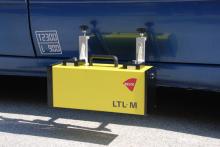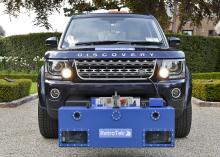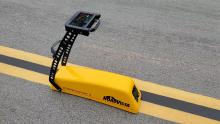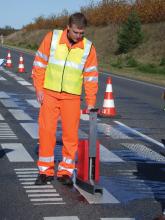Effective demarcation can play a crucial role in boosting safety for road users. Good demarcation is vital on a road network to help ensure that drivers stay in the correct lanes and are warned of changes that lie in their path, for example. Road markings are hugely important and for those involved in maintenance, ensuring that these are visible at night and in poor weather can help maximise safety. New technology is on the market now that can help road authorities ensure that road markings meet requirement
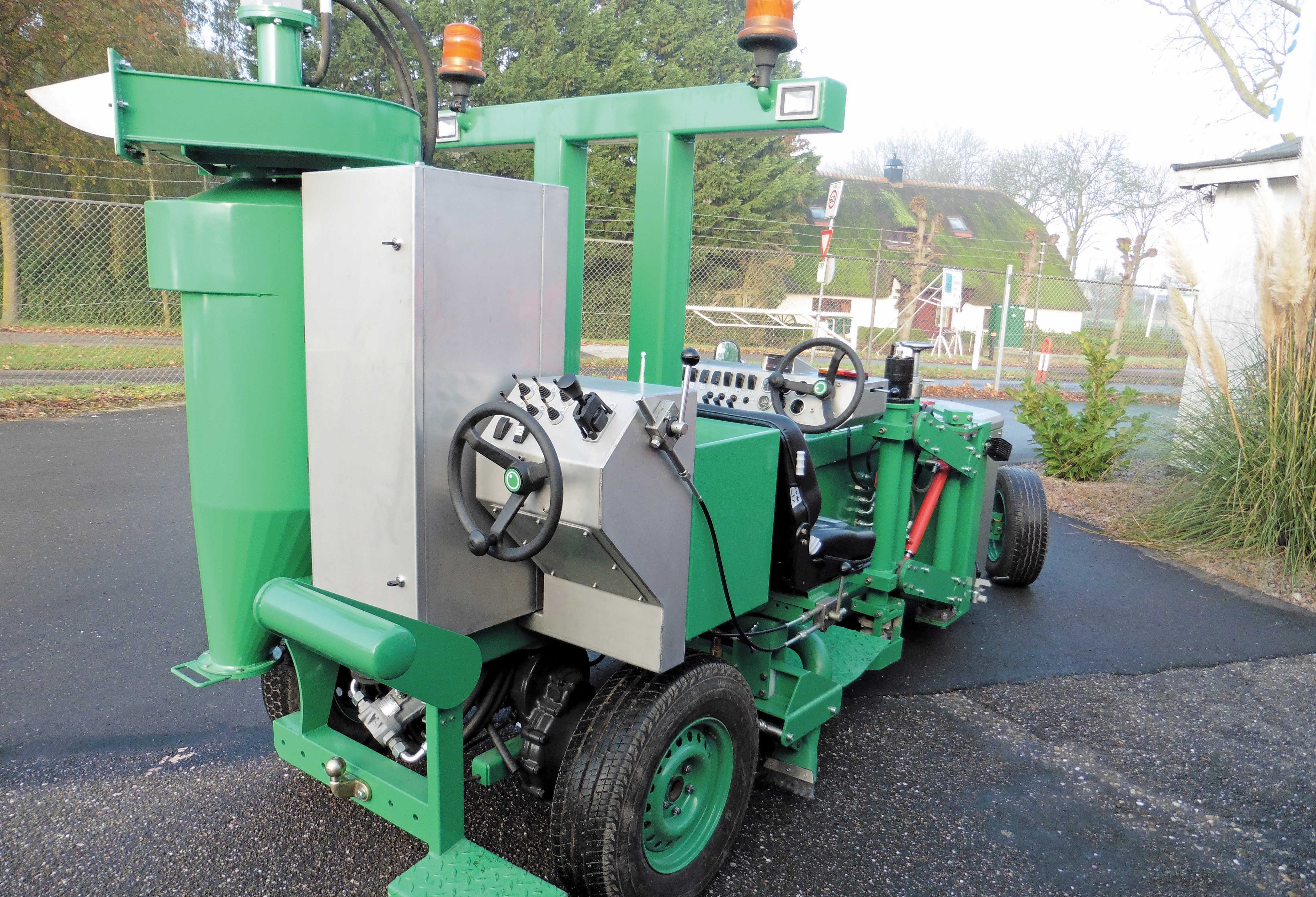
Van Wylick recently won an award for Qits novel road stud installation equipment
Effective demarcation can play a crucial role in boosting safety for road users
Good demarcation is vital on a road network to help ensure that drivers stay in the correct lanes and are warned of changes that lie in their path, for example. Road markings are hugely important and for those involved in maintenance, ensuring that these are visible at night and in poor weather can help maximise safety.
New technology is on the market now that can help road authorities ensure that road markings meet requirements. And the better the optical retroreflections of road markings, the more visible they are to drivers.
199 DELTA’s latest LTL-M mobile retroreflectometer for assessing road marking performance has improved 'its accuracy to match that of traditional handheld devices such as the DELTA’s LTL-X and LTL-XL models.
Working with a typical repeatability of +/- 3% and a typical reproducibility of +/- 5%, the LTL-M offers complete coverage of the entire pavement markings, in contrast to the limited sample-based coverage by conventional handheld retroreflectometers or even older generation mobile retroreflectometers.
First-generation retroreflectometers were less accurate due to vehicle movement changes, wind, and vehicle load variations that affected measurement geometry. Most mobile retroreflectometers work with 6m geometry. This means that the most accurate measurements are achieved when the system measures at, or close to, the 6m point. During driving, the measurement distance will typically fluctuate between 5 to 7m.
If a mobile system cannot compensate for such inaccuracies, incorrect readings will result. If the sensor unit is vertically lifted 5% or 1.2cm compared to the nominal measurement height, it results in readings 22% below the correct values. In parallel, if the sensor is tilted 5% off the horizontal level, it results in 10% too low readings.
The LTL-M measures 100% of the marking surface up to a speed of 90km/h. The LTL-M is therefore able to measure a detailed cross-sectional retroreflection of the markings. As many markings have strong transversal variation, a reading taken by a handheld instrument with a 4-5cm wide measurement field in the centre does not represent the true visibility.
The LTL-M gives a detailed analysis of the variation that can be correlated to either the true visibility, as the driver sees the marking in full width and length, or to a middle section for correlation to a handheld instrument.
The LTL-M also can measure accurately white and yellow markings without recalibration. Other key features include good linearity up to at least 2000 mcd/lx/m2; measurement of profiled markings up to 25mm, easy once-daily field calibration traceable to international standards and suppression of daylight to retain measurement accuracy.
The technology for applied measuring retroreflection of pavement markings are lined out, among others, in EN 1436 and4814 ASTM E 1710. Both standards describe a 30m geometry and the corresponding angles for illumination and observation, focusing on handheld retroreflectometers. Geometry of the existing mobile retroreflectometers follows these standards.
There are, however, task activities taking place both by CEN and ASTM to expand existing or write new standards to cover mobile measurement of markings. These standards are expected to follow the current 30m geometry.
But they will elaborate on potential error sources of the mobile technology, offer recommendations to the technical specifications of such an instrument and possibly require that instrument suppliers inform how their mobile system handle such conditions and the limitations of the instrument. This work is expected to be finalised within the coming two-year period.
Meanwhile,301 Pexco recently introduced the Enhanced Linear Delineation System (ELD), an alternative for improving night-driving safety on dangerous curves. The ELD products are designed to help combat the growing problem of 'roadway departure', identified as a top concern by the US 2410 Federal Highway Administration. Figures show that in the region of 25% of people who die each year on US roadways are killed in vehicle crashes at curves. The crash rate for horizontal curves is about three times that of other highway segments.
In the US, the night crash rate is three times that of the daytime rate. Pexco’s ELD system provides clear visual guidance to help drivers navigate through curves, work zones and other obstacles and road conditions.
Reflectors are a proven and cost-effective counter-measure to help prevent crashes at night and in adverse weather conditions. A closely spaced row of Pexco’s specialty reflectors creates a 'ribbon of light' to alert drivers of approaching curves. The ELD system gives drivers more time to react to avoid a crash.
The ELD system is applied directly on to guardrails and concrete barriers, providing drivers with a continuous retroreflective guide to changes in road geometry. On concrete barrier walls, Pexco’s Hi-Viz Flex Tab produces a 'ribbon of light' effect. Flex Tabs are available in 102mm and 152mm widths in a range of colours, including white, red, fluorescent orange and yellow.
On guardrails, Pexco’s Butterfly glue-on marker is used, with white, red, fluorescent orange or yellow sheeting. The suggested spacing of both products is from 457mm to 914mm on centre. Pexco ELD products have the additional advantage of offering 'wrong-way' red reflective tape on the back side of each marker.
The products are part of Pexco’s Davidson Traffic product line that includes Type I, II & III Barricades, channeliser posts, curb system lane separators, work-zone pavement markers and flexible delineator posts.
From8170 RoadVista comes its seventh generation reflectometer, the Laserlux G7, which features night-time colour measurement. RoadVista claimed that this is the first mobile retroreflectometer with the capability to determine if white and yellow stripes fall within the designated ASTM or CEN night-time colour boxes.
The unit will supersede the earlier Laserlux CEN 30 and the new model uses Simple Measurement Acquisition for Retroreflective Technology (SMART) for retroreflectivity readings at highway speeds. It quickly and securely mounts to almost any vehicle by way of a cinema-grade, four-leg mount with vacuum cups and safety strap.
Self-aligning and calibrating measurement is via automatic motorised height adjustment and levelling, all from the power of a standard 12V power outlet.
As standard features it measures the coefficient of retroreflection of pavement markings in the CEN 30m geometry and records this 400 times/second to ensure continuous coverage of the lines.
The G7 is also compatible with Android, iOS and Windows tablets and computers. There is wireless video camera with streaming overlay recorded and synced to the data stream. As well, data is conveniently stored in a removable USB flash drive so there is no hanging around to download data at the end of the day.
The unit will count and record raised retroreflective pavement markers (RRPMs). Calibration is fast, accurate and completely self-contained with no need to measure distances or find level ground. It also measures and records the width of the stripe, while RoadVista said a future refinement to the Laserlux G7 will be the ability to measure and record skip line lengths and spacing.
Dutch firm8169 Van Wylick has won an innovation award at the recent InfraTech show for its novel De Lux machine that installs road studs. The De Lux efficiently installs solid glass road studs within the surface of the road and not, as is traditional, on top of road.
Technical developments are speeding up the installation process, which was done partly by hand. The machine has a precise distance measurement system, an automatic adjustable drill bit and a sweep-and-suck installation. Double steering wheels means the machine is exceptionally manoeuvrable and can save time.
Van Wylick’s Lux solid glass road studs provide significant traffic safety in densely populated urban areas as well as rural areas. The Lux road stud meets European standard NEN-1463, is environmentally friendly and cost effective. Van Wylick said they work at any time, day and night, and in all weather conditions.
Good demarcation is vital on a road network to help ensure that drivers stay in the correct lanes and are warned of changes that lie in their path, for example. Road markings are hugely important and for those involved in maintenance, ensuring that these are visible at night and in poor weather can help maximise safety.
New technology is on the market now that can help road authorities ensure that road markings meet requirements. And the better the optical retroreflections of road markings, the more visible they are to drivers.
Working with a typical repeatability of +/- 3% and a typical reproducibility of +/- 5%, the LTL-M offers complete coverage of the entire pavement markings, in contrast to the limited sample-based coverage by conventional handheld retroreflectometers or even older generation mobile retroreflectometers.
First-generation retroreflectometers were less accurate due to vehicle movement changes, wind, and vehicle load variations that affected measurement geometry. Most mobile retroreflectometers work with 6m geometry. This means that the most accurate measurements are achieved when the system measures at, or close to, the 6m point. During driving, the measurement distance will typically fluctuate between 5 to 7m.
If a mobile system cannot compensate for such inaccuracies, incorrect readings will result. If the sensor unit is vertically lifted 5% or 1.2cm compared to the nominal measurement height, it results in readings 22% below the correct values. In parallel, if the sensor is tilted 5% off the horizontal level, it results in 10% too low readings.
The LTL-M measures 100% of the marking surface up to a speed of 90km/h. The LTL-M is therefore able to measure a detailed cross-sectional retroreflection of the markings. As many markings have strong transversal variation, a reading taken by a handheld instrument with a 4-5cm wide measurement field in the centre does not represent the true visibility.
The LTL-M gives a detailed analysis of the variation that can be correlated to either the true visibility, as the driver sees the marking in full width and length, or to a middle section for correlation to a handheld instrument.
The LTL-M also can measure accurately white and yellow markings without recalibration. Other key features include good linearity up to at least 2000 mcd/lx/m2; measurement of profiled markings up to 25mm, easy once-daily field calibration traceable to international standards and suppression of daylight to retain measurement accuracy.
The technology for applied measuring retroreflection of pavement markings are lined out, among others, in EN 1436 and
There are, however, task activities taking place both by CEN and ASTM to expand existing or write new standards to cover mobile measurement of markings. These standards are expected to follow the current 30m geometry.
But they will elaborate on potential error sources of the mobile technology, offer recommendations to the technical specifications of such an instrument and possibly require that instrument suppliers inform how their mobile system handle such conditions and the limitations of the instrument. This work is expected to be finalised within the coming two-year period.
Meanwhile,
In the US, the night crash rate is three times that of the daytime rate. Pexco’s ELD system provides clear visual guidance to help drivers navigate through curves, work zones and other obstacles and road conditions.
Reflectors are a proven and cost-effective counter-measure to help prevent crashes at night and in adverse weather conditions. A closely spaced row of Pexco’s specialty reflectors creates a 'ribbon of light' to alert drivers of approaching curves. The ELD system gives drivers more time to react to avoid a crash.
The ELD system is applied directly on to guardrails and concrete barriers, providing drivers with a continuous retroreflective guide to changes in road geometry. On concrete barrier walls, Pexco’s Hi-Viz Flex Tab produces a 'ribbon of light' effect. Flex Tabs are available in 102mm and 152mm widths in a range of colours, including white, red, fluorescent orange and yellow.
On guardrails, Pexco’s Butterfly glue-on marker is used, with white, red, fluorescent orange or yellow sheeting. The suggested spacing of both products is from 457mm to 914mm on centre. Pexco ELD products have the additional advantage of offering 'wrong-way' red reflective tape on the back side of each marker.
The products are part of Pexco’s Davidson Traffic product line that includes Type I, II & III Barricades, channeliser posts, curb system lane separators, work-zone pavement markers and flexible delineator posts.
From
The unit will supersede the earlier Laserlux CEN 30 and the new model uses Simple Measurement Acquisition for Retroreflective Technology (SMART) for retroreflectivity readings at highway speeds. It quickly and securely mounts to almost any vehicle by way of a cinema-grade, four-leg mount with vacuum cups and safety strap.
Self-aligning and calibrating measurement is via automatic motorised height adjustment and levelling, all from the power of a standard 12V power outlet.
As standard features it measures the coefficient of retroreflection of pavement markings in the CEN 30m geometry and records this 400 times/second to ensure continuous coverage of the lines.
The G7 is also compatible with Android, iOS and Windows tablets and computers. There is wireless video camera with streaming overlay recorded and synced to the data stream. As well, data is conveniently stored in a removable USB flash drive so there is no hanging around to download data at the end of the day.
The unit will count and record raised retroreflective pavement markers (RRPMs). Calibration is fast, accurate and completely self-contained with no need to measure distances or find level ground. It also measures and records the width of the stripe, while RoadVista said a future refinement to the Laserlux G7 will be the ability to measure and record skip line lengths and spacing.
Dutch firm
Technical developments are speeding up the installation process, which was done partly by hand. The machine has a precise distance measurement system, an automatic adjustable drill bit and a sweep-and-suck installation. Double steering wheels means the machine is exceptionally manoeuvrable and can save time.
Van Wylick’s Lux solid glass road studs provide significant traffic safety in densely populated urban areas as well as rural areas. The Lux road stud meets European standard NEN-1463, is environmentally friendly and cost effective. Van Wylick said they work at any time, day and night, and in all weather conditions.

